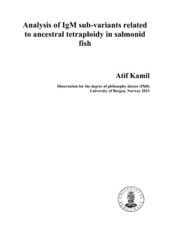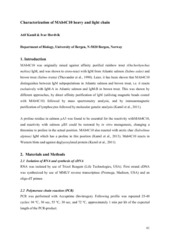| dc.contributor.author | Kamil, Atif | eng |
| dc.date.accessioned | 2013-04-17T12:04:37Z | |
| dc.date.available | 2013-04-17T12:04:37Z | |
| dc.date.issued | 2013-03-21 | eng |
| dc.identifier.isbn | 978-82-308-2257-9 | en_US |
| dc.identifier.uri | http://hdl.handle.net/1956/6527 | |
| dc.description.abstract | Atlantic salmon (Salmo salar) and brown trout (Salmo trutta) possess two paralogous IgM heavy chain (μ) genes related to ancestral tetraploidy. Accordingly, IgM subpopulations of Atlantic salmon and brown trout can be separated by gradient anion exchange chromatography (AEC) into two distinct peaks. In contrast, IgM of arctic char (Salvelinus alpinus) and rainbow trout (Oncorhynchus mykiss) is eluted in a single peak. In the present study mass spectrometry analysis verified that IgM of peak 1 (subpopulation 1) have heavy chains previously designated as μB type whereas IgM of peak 2 (subpopulation 2) have heavy chains of μA type, in Atlantic salmon and brown trout. Salmon IgM of both peak 1 and peak 2 contain light chains of the two most common isotypes: IgL1 and IgL3. Two adjacent cysteine residues are present near the C-terminal part of μB, in contrast to one cysteine residue in μA. Most likely, the additional cysteine is involved in inter-chain disulfide bonding and influences the elution profiles of IgM-A and IgM-B on AEC. Molecular cloning of μ cDNA from arctic char revealed two sub-variants (μA-1 and μA-2), and hybrids of char/salmon expressed μA-1, μA-2, μA and μB, indicating that there are two paralogous μ loci in the haploid genome of char, like in Atlantic salmon. Neither of the μ sub-variants in arctic char have the additional cysteine, and char IgM, as well as salmon and brown trout IgM-A, show a lower degree of inter-chain disulfide bonding than IgM-B when subjected to denaturation and gel electrophoresis under non-reducing conditions. Surprisingly, a monoclonal antibody MAb4C10 against rainbow trout IgM, reacted with μA in salmon, whereas in brown trout it reacted with μB. MAb4C10 was conjugated to magnetic beads and used to separate cells, demonstrating that μ transcripts residing from captured cells were primarily of A type in salmon and B type in brown trout. It is plausible to assume that DNA has been exchanged between the paralogous A and B loci during evolution while maintaining the two sub-variants, with and without the extra cysteine. An analysis of amino acid substitutions in μA and μB of salmon and brown trout indicated that the third constant domain is essential for MAb4C10 binding. This was supported by 3D modeling and was finally verified by studies of MAb4C10 reactivity with a series of recombinant μ3 constructs. Substitution of a proline residue located in the loop between the B and C beta strands of salmon μΑ3 eliminated MAb4C10 reactivity. Accordingly, the reverse substitution in salmon μB restored MAb4C10 reactivity. Molecular cloning of MAb4C10 cDNA and mass spectrometry analysis confirmed that MAb4C10 is of IgG-1 subtype, and the VH sequence of MAb4C10 was determined. To reveal possible differential expression of IgM-A and IgM-B, a broad spectrum of samples from previous and ongoing experiments (fresh water and salt water) and unvaccinated/vaccinated diploid and triploid fish were analyzed. The μA and μB genes appeared to be uniformly expressed in a series of tissues, whereas the AEC profiles of purified IgM from vaccinated fish indicated that the A:B ratio can be skewed in challenged fish. | en_US |
| dc.language.iso | eng | eng |
| dc.publisher | The University of Bergen | en_US |
| dc.relation.haspart | Paper I: Kamil A., Falk K., Sharma A., Raae A., Berven F., Koppang E. O. and Hordvik I. (2011) A monoclonal antibody distinguishes between two IgM heavy chain isotypes in Atlantic salmon and brown trout: protein characterization, 3D modeling and epitope mapping. Molecular Immunology 48(15–16): 1859–1867, September 2011. Full text not available in BORA due to publisher restrictions. The article is available at: <a href="http://dx.doi.org/10.1016/j.molimm.2011.05.005" target="blank"> http://dx.doi.org/10.1016/j.molimm.2011.05.005</a> | en_US |
| dc.relation.haspart | Paper II: Kamil A., Raae A., Fjelldal P. G., Koppang E. O., Kari F. E. and Hordvik I. (2013) Comparative analysis of IgM sub-variants in salmonid fish and identification of a residue in μ3 which is essential for MAb4C10 reactivity. Fish and Shellfish Immunology 34(2): 667–672, February 2013. Full text not available in BORA due to publisher restrictions. The article is available at: <a href="http://dx.doi.org/10.1016/j.fsi.2012.12.006" target="blank"> http://dx.doi.org/10.1016/j.fsi.2012.12.006</a> | en_US |
| dc.relation.haspart | Paper III: Kamil A., Fjelldal P. G., Hansen T., Raae A., Koppang E. O. and Hordvik I. Analysis of serum immunoglobulin and Ig heavy chain gene expression in vaccinated versus unvaccinated Atlantic salmon. Full text not available in BORA. | en_US |
| dc.title | Analysis of IgM sub-variants related to ancestral tetraploidy in salmonid fish | en_US |
| dc.type | Doctoral thesis | |
| dc.rights.holder | Copyright the author. All rights reserved | en_US |

